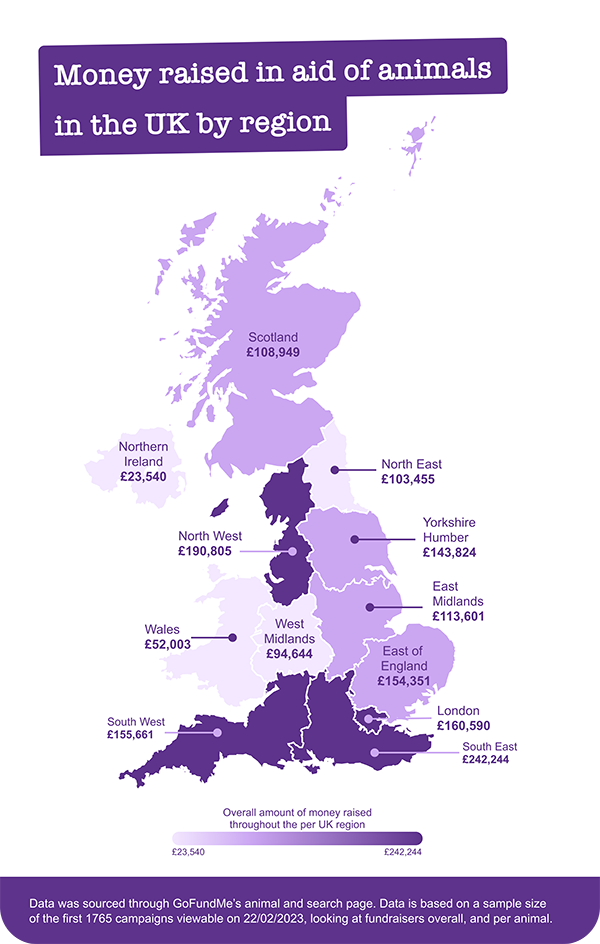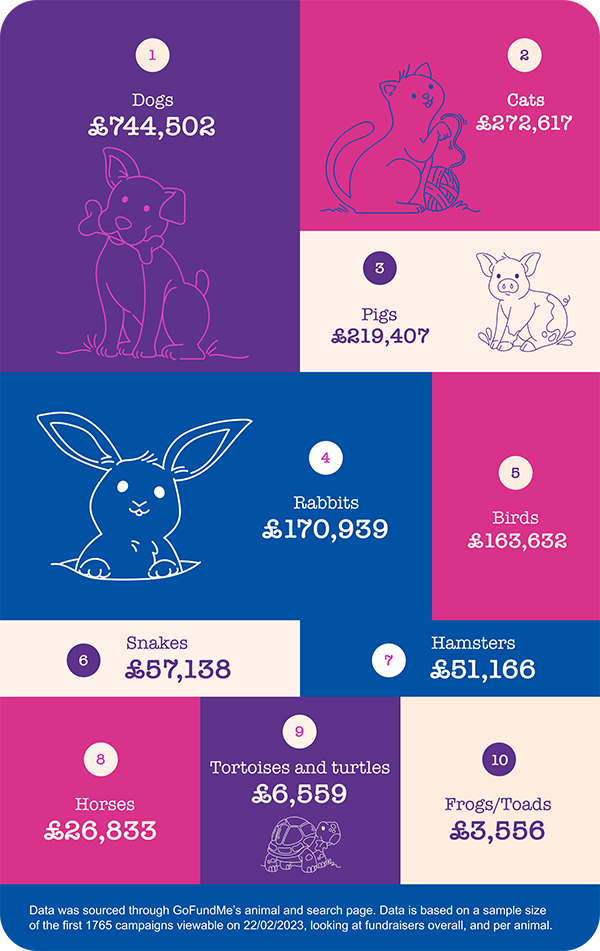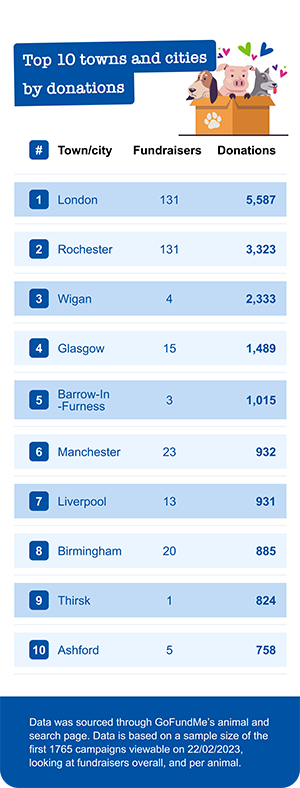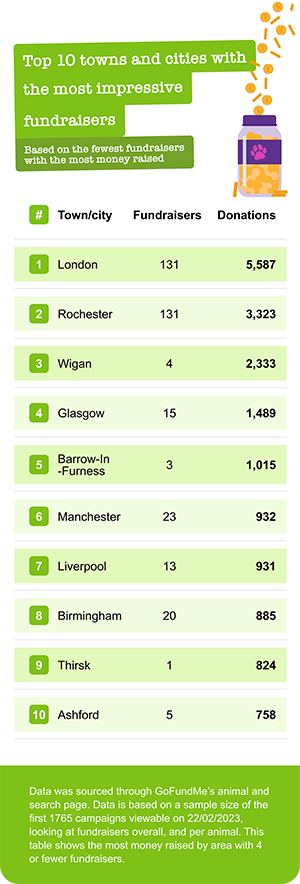Where in the UK are people most generous when it comes to pets in need? We analysed 100s of active GoFundMe campaigns to find out.
Furry fundraisers - how much money does the UK raise for pets?
Our pets are our best friends, but sometimes they can also be one of our biggest costs. Unlike humans, they can’t tell us when things are wrong which means taking them to the vet is the only option to find out.
Most treatments and procedures will be covered by your pet insurance, but it's crucial to make sure you have the right policy in place for your pet. If you don't you might risk having to cover bigger veterinary costs than you expected.
As well as having pet insurance, some people have chosen crowdfunding to help with their pets’ health problems. But where in the country are people raising the most? And, which animals prove the most costly to look after? We analysed more than 1,700 UK-based, active fundraising campaigns from the crowdfunding platform GoFundMe to answer these questions, and more.
How much have active campaigns raised in total?
One thing is clear: people really care about pets! Based on our sample of active GoFundMe campaigns a total of £1.83m was donated in February 2023. That’s a huge amount of money donated in aid of our beloved pets. We analysed 1,765 active private fundraising campaigns, with 73,894 very charitable donations made in total.

Which UK region receives the most money towards their animal fundraisers?
As a nation, the UK is happy to raise money for an animal in need, but the South East was the biggest recipient. Local fundraisers generated £242,244 across all active animal fundraising campaigns in the region.
The North West was the region in second place, receiving £190,805 for animal causes and knocking London into third with £160,590.

The towns and cities that receive the most money
What about the places where the most money ends up? Some parts of the UK appear to have a greater need for animal aid than others, London in particular. Fundraisers based in London totalled £160,590 in donations for animal causes as of February 2023, with Rochester coming some way back in second at £57,904. Glasgow completes this top three with a grand total of £25,427 received by local crowdfunding campaigns.
It’s important to remember that fundraising for animal aid isn’t an alternative for reliable insurance cover. It’s always worth doing your research and seeking out the right pet insurance policy to give you peace of mind in case something does go wrong.

The towns and cities who receive the most individual donations
When it comes to towns and cities, London took the top spot, receiving the most individual donations across their 131 active animal fundraisers. In total, the Capital received 5,587 donations come in from people all over the country and the world. Rochester came in second place with 3,323 donations.
In third place is Wigan. The town received an incredible 2,333 donations across just four active fundraisers.

Which towns and cities have the most dedicated donors?
When it comes to fundraisers, any donation is appreciated but some donors are extra generous! These people can make a massive difference to fundraising efforts.
Despite having only two active animal fundraisers, Todmorden in West Yorkshire received a grand total of £41,796. Making the list once again, Wigan raised a huge £33,290 between four live campaigns. Sunderland was home to three fundraisers totalling £25,493 in donations to pet and animal causes.

The animals that make the most money
If you think you can guess which animals garner the most donations, you’re probably spot on. Causes for dogs fetch the most, with a total of £744,502 donated across fundraisers live as of February 2023. Cats might be the next one you predict, and they came in second with donations totalling £272,617.
Perhaps less predictably, pigs come in third as the animal most likely to tug on people’s heart strings. Piggy causes drew a total of £219,407 donations.

What our pet experts say
1. Why is it important to have pet insurance?
There are many reasons that it’s important to insure your pet. First and foremost, pet insurance can help you cover the cost of veterinary bills. If your pet gets ill or is injured, the right pet insurance policy will give you peace of mind that you’ll be able to cover the cost of their care, and reduce the financial stresses that come with unexpected bills. What’s more, lifetime pet insurance policies will ensure that your pet is covered for any lifelong conditions they are diagnosed with after the cover started. This means that you can continue to access veterinary care for that condition throughout your pet’s life.
Just like us, pets can get ill or injured at any time so it’s important to make sure you have the right cover in place to be able to get them the best care you can. Not all pet insurance policies are the same, and finding the right cover from day one is really important.
Asking these questions can help you decide what cover is just right for your pet’s needs:
- Will my pet’s symptoms or condition be covered for life?
- Are there any limits per condition within the vet fee cover?
- Does the policy cover dental illness and injury?
- Will my premiums go up as a result of claiming against the policy?
Alongside vet fees and dental care, Petplan policies also provide cover for missing pets, diagnostic tests and scans, complementary treatments and behavioural conditions, as standard.
2. Why shouldn’t pet owners rely on fundraisers to foot the bill for veterinary costs for their pets?
Veterinary costs are often sudden and unforeseen, or ongoing. If your pet needs immediate care, you won’t want to wait before you are able to take them to the vet and, whilst it might seem like a good idea, fundraising for your pet’s care could take a very long time. Your pet’s condition could get worse during this period, which risks prolonging your pet’s distress, as well as increasing the costs of veterinary care.
What’s more, you cannot rely on people to donate to your pet’s care fund and you may quickly find yourself out of options if you don’t receive the donations you need.
Furthermore, some treatments are required over the longer term. Whilst fundraising may work over the short term, perhaps to cover the cost of an initial operation, it is rarely viable over the longer term for ongoing care and medications.
If you would struggle to pay an unexpected vet bill, it’s always best to take out a pet insurance policy to alleviate some financial concerns.
3. What should you do if your current pet insurance plan doesn’t cover the extent of your pet’s treatment? Is fundraising a viable option then?
All pet insurance policies have a vet fee limit in place. Some also have additional limits hidden within the small print of your policy documents. Make sure you understand what medical conditions your policy covers, and for how much and how long before committing to a policy.
Unfortunately, if your existing policy does not cover your current vet bills, switching providers for a different policy won't help and the new policy will not be able to cover the current costs. This is because the current symptoms (as well as any previous ones) will be labelled as pre-existing – even if your pet has recovered from the illness that caused them.
Again, whilst there’s nothing to stop you fundraising for your pet, it’s important to remember that this can take time and is not a failsafe method. You could be prolonging your pet’s distress or even putting them in danger by not seeking veterinary help sooner.
4. Are there any medical conditions that aren’t covered by pet insurance?
There are various different types of pet insurance cover. The four main types are:
- Accident-only
- Time-limited
- Maximum benefit
- Lifetime
As the name suggests, accident-only cover applies to conditions caused by an accident, such as a road-traffic accident or ingesting something they shouldn’t. These types of policy will not cover you for illnesses or diseases.
Whether you purchase a time-limited, maximum-benefit or lifetime cover policy, you’ll need to understand the exclusions that may be placed on your particular policy – these are costs that your pet insurer will not cover. When you take out a policy on a perfectly healthy puppy, kitten or baby rabbit, there are unlikely to be any exclusions on your policy.
However, if your pet has shown symptoms of a condition and/or has been treated for an illness or injury, these conditions may not be covered on a new policy as they are now referred to as a pre-existing condition. A pre-existing condition could be placed on your existing policy on renewal, or on a new policy if you switch providers. Note that a pre-existing condition doesn’t mean that the cause of the symptoms has been diagnosed. If your pet has received treatment for a limp for example, even though the exact cause of that limp was never diagnosed, your new insurer is unlikely to cover any costs related to limping on your policy. If your pet is already insured before the limp started then your insurer should cover costs related to diagnosing or treating it, provided they fall within your vet fee limits and have not already been excluded.
Pre-existing symptoms and conditions are a common cause of declined claims, so it's important to read your insurance documents carefully when switching or renewing your policy.
Depending on your insurance provider, a time-limited policy may offer cover for 12 months from when your pet first exhibited that symptom or condition. On other policies, such as Petplan's Essential policy, your pet is covered for 12 months after starting treatment, covering vet bills up to £3,000. Many pet owners who have insured their pet using a time-limited policy assume that they have one year of cover from when they start claiming. This means that they sometimes consent to costly investigations and treatments assuming they are covered because they haven’t claimed yet.
Sometimes a pet owner will only realise a symptom or condition is excluded when their claim is declined by the insurer, because they check a pet’s medical records to see whether they’ve previously suffered from these symptoms. If this has happened more than a year ago, this claim will be declined.
This does not happen, however, when a pet has been insured continuously via a lifetime policy. This is by far the major advantage of taking out one of these policies when your pet is young and perfectly healthy. Most pet insurers also don’t cover routine vaccinations, parasite control, microchipping and neutering. These are all essential parts of responsible pet ownership so you’ll need to budget for these separately.
5. If you can’t afford pet insurance, where should you turn?
Whilst it does add an additional cost to your monthly outgoings, a good quality pet insurance policy is the best way to ensure you’re financially supported if something does happen to your pet, as vet fees can be surprisingly expensive.
However, if you are really struggling to foot the bill, there are some charities you can turn to for help. PDSA offers means-tested veterinary support to some pet owners; to qualify for their support you need to be receiving certain benefits, such as housing or council tax support, and live within the catchment area of a PDSA centre. The Blue Cross operates a similar scheme and the RSPCA offers reduced-cost vet care to pet owners who meet their criteria.
Methodology
All data is up-to-date as of 22/02/2023.
Data was sourced through GoFundMe's animal and search page. Data is based on a
sample size of the first 1765 campaigns that were active and viewable on 22/02/2023. From the sample we identified, we then broke down the results by number of fundraisers overall; number of individual donations made; amount of money raised by fundraisers; the locations which receive the most donations; and by which animal each fundraiser was in aid of.





